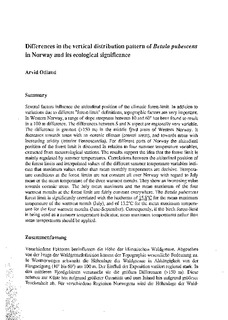| dc.contributor.author | Odland, Arvid | |
| dc.date.accessioned | 2013-05-21T07:25:50Z | |
| dc.date.accessioned | 2017-04-19T12:24:56Z | |
| dc.date.available | 2013-05-21T07:25:50Z | |
| dc.date.available | 2017-04-19T12:24:56Z | |
| dc.date.issued | 1996 | |
| dc.identifier.citation | Odland, A. Differences in the vertical distribution pattern of Betula pubescens in Norway and its ecological significance. In: Frenzel, B. (editor). Holocene treeline oscillations, dendrochronology and palaeoclimate; p. 43-59. Stuttgart: Gustav Fischer, 1996 | |
| dc.identifier.isbn | 3-437-25386-7 | |
| dc.identifier.isbn | 1-56081-447-0 | |
| dc.identifier.uri | http://hdl.handle.net/11250/2438009 | |
| dc.description.abstract | Several factors influence the altitudinal position of the climatic forest-limit. In addition to variations due to different "forest-limit" definitions, topographic factors are very important. In Western Norway, a range of slope steepness between 10 and 60° has been found to result in a 100 m difference. The differences between S and N aspect are regionally very variable. The difference is greatest (> 150 m) in the middle fjord areas of Western Norway. It decreases towards areas with an oceanic climate (coastal areas), and towards areas with increasing aridity (interior Fennoscandia). For different parts of Norway the altitudinal position of the forest limit is discussed in relation to four summer temperature variables, extracted from meteorological stations. The results support the idea that the forest limit is mainly regulated by summer temperatures. Correlations between the altitudinal position of the forest limits and interpolated values of the different summer temperature variables indicate that maximum values rather than mean monthly temperatures are decisive. Temperature conditions at the forest limits are not constant all over Norway with regard to July mean or the mean temperature of the three warmest months. They show an increasing value towards oceanic areas. The July mean maximum and the mean maximum of the four warmest months at the forest limit are fairly constant everywhere. The Betula pubescens forest limit is significantly correlated with the isotherms of 15.8 C, for the mean maximum temperature of the warmest month (July), and of 13.2 C for the mean maximum temperature for the four warmest months (June-September). Consequently, if the birch forest-limit is being used as a summer temperature indicator, mean maximum temperatures rather than mean temperatures should be applied. | |
| dc.language.iso | eng | |
| dc.publisher | Gustav Fischer | |
| dc.title | Differences in the vertical distribution pattern of Betula pubescens in Norway and its ecological significance | |
| dc.type | Chapter | |
| dc.type | Peer reviewed | |
| dc.description.version | Published version | |
| dc.rights.holder | 1996 © Gustav Fischer Verlag Stuttgart. Reproduced with permission | |
| dc.subject.nsi | 488 | |
